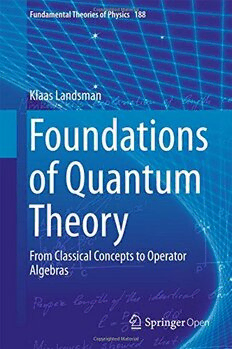
Foundations of quantum theory : from classical concepts to commutative operator algebras PDF
Preview Foundations of quantum theory : from classical concepts to commutative operator algebras
Fundamental Theories of Physics 188 Klaas Landsman Foundations of Quantum Theory From Classical Concepts to Operator Algebras Fundamental Theories of Physics Volume 188 Series editors Henk van Beijeren, Utrecht, The Netherlands Philippe Blanchard, Bielefeld, Germany Paul Busch, York, UK Bob Coecke, Oxford, UK Dennis Dieks, Utrecht, The Netherlands Bianca Dittrich, Waterloo, Canada Detlef Dürr, München, Germany Ruth Durrer, Genève, Switzerland Roman Frigg, London, UK Christopher Fuchs, Boston, USA Giancarlo Ghirardi, Trieste, Italy Domenico J.W. Giulini, Bremen, Germany Gregg Jaeger, Boston, USA Claus Kiefer, Köln, Germany Nicolaas P. Landsman, Nijmegen, The Netherlands Christian Maes, Leuven, Belgium Mio Murao, Bunkyo-ku, Japan Hermann Nicolai, Potsdam, Germany Vesselin Petkov, Montreal, Canada Laura Ruetsche, Ann Arbor, USA Mairi Sakellariadou, London, UK Alwyn van der Merwe, Denver, USA Rainer Verch, Leipzig, Germany Reinhard Werner, Hannover, Germany Christian Wüthrich, Geneva, Switzerland Lai-Sang Young, New York City, USA The international monograph series “Fundamental Theories of Physics” aims to stretch the boundaries of mainstream physics by clarifying and developing the theoreticalandconceptualframeworkofphysicsandbyapplyingittoawiderange ofinterdisciplinaryscientificfields.Originalcontributionsinwell-establishedfields such as Quantum Physics, Relativity Theory, Cosmology, Quantum Field Theory, Statistical Mechanics and Nonlinear Dynamics are welcome. The series also provides a forum for non-conventional approaches to these fields. Publications should present new and promising ideas, with prospects for their further development, and carefully show how they connect to conventional views of the topic. Although the aim of this series is to go beyond established mainstream physics, a high profile and open-minded Editorial Board will evaluate all contributions carefully to ensure a high scientific standard. More information about this series at http://www.springer.com/series/6001 Klaas Landsman Foundations of Quantum Theory From Classical Concepts to Operator Algebras KlaasLandsman IMAPP Radboud University Nijmegen TheNetherlands ISSN 0168-1222 ISSN 2365-6425 (electronic) FundamentalTheories of Physics ISBN978-3-319-51776-6 ISBN978-3-319-51777-3 (eBook) DOI 10.1007/978-3-319-51777-3 LibraryofCongressControlNumber:2017933673 ©TheAuthor(s)2017.Thisbookisanopenaccesspublication. Open Access This book is licensed under the terms of the Creative Commons Attribution 4.0 International License (http://creativecommons.org/licenses/by/4.0/), which permits use, sharing, adaptation,distributionandreproductioninanymediumorformat,aslongasyougiveappropriatecredit totheoriginalauthor(s)andthesource,providealinktotheCreativeCommonslicenseandindicateif changesweremade. The images or other third party material in this book are included in the book’s Creative Commons license,unlessindicatedotherwiseinacreditlinetothematerial.Ifmaterialisnotincludedinthebook’s CreativeCommonslicenseandyourintendeduseisnotpermittedbystatutoryregulationorexceedsthe permitteduse,youwillneedtoobtainpermissiondirectlyfromthecopyrightholder. The use of general descriptive names, registered names, trademarks, service marks, etc. in this publicationdoesnotimply,evenintheabsenceofaspecificstatement,thatsuchnamesareexemptfrom therelevantprotectivelawsandregulationsandthereforefreeforgeneraluse. The publisher, the authors and the editors are safe to assume that the advice and information in this book are believed to be true and accurate at the date of publication. Neither the publisher nor the authorsortheeditorsgiveawarranty,expressorimplied,withrespecttothematerialcontainedhereinor for any errors or omissions that may have been made. The publisher remains neutral with regard to jurisdictionalclaimsinpublishedmapsandinstitutionalaffiliations. Printedonacid-freepaper ThisSpringerimprintispublishedbySpringerNature TheregisteredcompanyisSpringerInternationalPublishingAG Theregisteredcompanyaddressis:Gewerbestrasse11,6330Cham,Switzerland ToJeremyButterfield Preface ‘DerKopf,sogesehen,hatmitdemKopf,sogesehen,auchnichtdieleisesteA¨hnlichkeit (...) Der Aspektwechsel. “Du wu¨rdest doch sagen, dass sich das Bild jetzt ga¨nzlich gea¨ndert hat!” Aber was ist anders: mein Eindruck? meine Stellungnahme? (...) Ich beschreibedieA¨nderungwieeineWahrnehmung,ganz,alsha¨ttesichderGegenstandvor meinenAugengea¨ndert.’(Wittgenstein,PhilosophischeUntersuchungenII,§§127,129).1 Asthewell-knownpictureaboveismeanttoallegorize,somephysicalsystems admitadualdescriptionineitherclassicalorquantum-mechanicalterms.According to Bohr’s “doctrine of classical concepts”, measurement apparatuses are examples ofsuchsystems.Moregenerally—ashammereddownbydecoherencetheorists— theclassicalworldaroundusisacaseinpoint.Aswillbearguedinthisbook,the measurementproblemofquantummechanics(highlightedbySchro¨dinger’sCat)is causedbythisduality(ratherthanresolvedbyit,asBohrissaidtohavethought). 1‘Theheadseeninthiswayhasn’teventheslightestsimilaritytotheheadseeninthatway(...) Thechangeofaspect.“Butsurelyyou’dsaythatthepicturehaschangedaltogethernow!Butwhat isdifferent:myimpression?myattitude?(...)Idescribethechangelikeaperception;justasifthe objecthaschangedbeforemyeyes.’Translation:G.E.M.Anscombe,P.M.S.Hacker,&J.Schulte (Wittgenstein,2009/1953,pp.205–206). vii viii Preface The aim of this book is to analyze the foundations of quantum theory from the point of view of classical-quantum duality, using the mathematical formalism of operatoralgebrasonHilbertspace(and,moregenerally,C*-algebras)thatwasorig- inallycreatedbyvonNeumann(followedbyGelfandandNaimark).Insupportof thisanalysis,butalsoasamatterofindependentinterest,thebookcoversmanyof the traditional topics one might expect to find in a treatise on the foundations of quantummechanics,likepureandmixedstates,observables,theBornruleandits relationtobothsingle-caseprobabilitiesandlong-runfrequencies,Gleason’sTheo- rem,thetheoryofsymmetry(includingWigner’sTheoremanditsrelatives,culmi- natinginarecenttheoremofHamhalter’s),Bell’sTheorem(s)andthelike,quantiza- tiontheory,indistinguishableparticle,largesystems,spontaneoussymmetrybreak- ing, the measurement problem, and (intuitionistic) quantum logic. One also finds a few idiosyncratic themes, such as the Kadison–Singer Conjecture, topos theory (whichnaturallyinjectsintuitionismintoquantumlogic),andanunusualemphasis onbothconceptualandmathematicalaspectsoflimitsinphysicaltheories. AllofthisisheldtogetherbywhatwecallBohrification,i.e.,themathematical interpretation of Bohr’s classical concepts by commutative C*-algebras, which in turnarestudiedintheirquantumhabitatofnoncommutativeC*-algebras. Thusthebookismostlywritteninmathematicalphysicsstyle,butitsrealsubject isnaturalphilosophy.Henceitsintendedreadershipconsistsnotonlyofmathemati- calphysicists,butalsoofphilosophersofphysics,aswellasoftheoreticalphysicists whowishtodomorethan‘shutupandcalculate’,andfinallyofmathematicianswho areinterestedinthemathematicalandconceptualstructureofquantumtheory. Toserveallthesegroups,thenativemathematicallanguage(i.e.ofC*-algebras) isintroducedslowly,startingwithfinitesets(asclassicalphasespaces)andfinite- dimensionalHilbertspaces.Inaddition,alladvancedmathematicalbackgroundthat is necessary but may distract from the main development is laid out in extensive appendices on Hilbert spaces, functional analysis, operator algebras, lattices and logic, and category theory and topos theory, so that the prerequisites for this book are limited to basic analysis and linear algebra (as well as some physics). These appendices not only provide a direct route to material that otherwise most readers wouldhaveneededtoextractfromthousandsofpagesofdiversetextbooks,butthey alsocontainsomeoriginalmaterial,andmaybeofinteresteventomathematicians. Insummary,theaimsofthisbookaresimilartothoseofitspeerlessparadigm: ‘DerGegenstanddiesesBuchesistdieeinheitliche,und,soweitalsmo¨glichundangebracht, mathematischeinwandfreieDarstellungderneuenQuantenmechanik(...).Dabeisolldas HauptgewichtaufdieallgemeinenundprinzipiellenFragen,dieimZusammenhangemit dieser Theorie entstanden sind, gelegt werden. Insbesondere sollen die schwierigen und vielfachnochimmernichtrestlosgekla¨rtenInterpretationsfragenna¨heruntersuchtwerden.’ (vonNeumann,MathematischeGrundlagenderQuantenmechanik,1932,p.1).2 2‘Theobjectofthisbookistopresentthenewquantummechanicsinaunifiedpresentationwhich, sofarasitispossibleanduseful,ismathematicallyrigorous.(...)Thereforetheprincipalemphasis shallbeplacedonthegeneralandfundamentalquestionswhichhaveariseninconnectionwiththis theory.Inparticular,thedifficultproblemswithinterpretation,manyofwhichareevennownot fullyresolved,willbeinvestigatedindetail.’Translation:R.T.Beyer(vonNeumann,1955,p.vii). Preface ix Twootherquotationstheauthoroftenhadinmindwhilewritingthisbookare: ‘Andalthoughthewholeofphilosophyisnotimmediatelyevident,stillitisbettertoadd somethingtoourknowledgedaybydaythantofillupmen’smindsinadvancewiththe preconceptionsofhypotheses.’(Newton,draftprefacetoPrincipia,1686).3 ‘JuisthetfeitdateengeniealsDESCARTESvolkomennaastdelijnvanontwikkelingisbli- jvenstaan,dievanGALILEInaarNEWTONvoert(...)[is]eenphasevandenindehistorie zoovaakherhaaldenstrijdtusschendebescheidenheiddermathematisch-physischemeth- ode,dienanauwkeurigonderzoekdeverschijnselendernatuurinsteedsmeeromvattende schematametbehulpvandeexactetaaldermathesiswilbeschrijvenendenhoogmoedvan hetphilosophischedenken,datine´e´ngenialengreepdeheelewereldwilomvatten(...).’ (Dijksterhuis,ValenWorp,1924,p.343).4 Acknowledgements 1. Researchunderlyingthisbookhasbeengenerouslysupportedby: • RadboudUniversityNijmegen,partlythroughasabbaticalin2014. • The Netherlands Organization for Scientific Research (NWO), initially by funding various projects eventually contributing to this book, and most re- centlybypayingtheOpenAccessfee,makingthebookwidelyavailable. • TheTempletonWorldCharityFoundation(TWCF),byfundingtheOxford– Princeton–NijmegencollaborationExperimentalTestsofQuantumReality. • Trinity College (Cambridge), by appointing the author as a Visiting Fellow CommonerduringtheEasterTerm2016,whenthebookwaslargelyfinished. 2. Theauthorwasfortunateinhavingbeensurroundedbyoutstandingstudentsand postdocs,whomadeessentialcontributionstotheinsightsdescribedinthisbook. InalphabeticalorderthesewereChristianBudde,MartijnCaspers,RonnieHer- mens, Jasper van Heugten, Chris Heunen, Bert Lindenhovius, Robin Reuvers, BasSpitters,MarcoStevens,andSanderWolters.Thosewerethedays! 3. The author is indebted to Jeremy Butterfield, Peter Bongaarts, Harvey Brown, DennisDieks,SiegfriedEchterhoff,AernoutvanEnter,JanHamhalter,Jaapvan Oosten,andBasTerwijnforcommentsonthemanuscript.Inaddition,through critical feedback on a Masterclass at Trinity, Owen Maroney and Fred Muller indirectly(butconsiderably)improvedChapter11onthemeasurementproblem. 4. AngelaLaheefromSpringerthoughtfullyguidedthepublicationprocessofthis bookfromthebeginningtotheend.ThanksalsotohercolleagueAldoRampioni. Finally,itisapleasuretodedicatethisbooktoJeremyButterfield,inrecognitionof hisideas,aswellasofhisunrelentingsupportandfriendshipoverthelast25years. 3Newton(1999),p.61. 4‘TheveryfactthatageniuslikeDescarteswascompletelysidelinedinthedevelopmentleading fromGalileitoNewton(...)representsaphaseinthestruggle—thathassooftenbeenrepeated throughout history—between the modesty of the approach of mathematical physics, which af- terpreciseinvestigationsattemptstodescribenaturalphenomenainincreasinglycomprehensive schemesusingtheexactlanguageofmathematics,andthehaughtinessofphilosophicalthought, whichwantstocomprehendtheentireworldinonedazzlinggrasp.’Translationbytheauthor. Contents Introduction ....................................................... 1 PartI C (X)andB(H) 0 1 Classicalphysicsonafinitephasespace .......................... 23 1.1 Basicconstructionsofprobabilitytheory ....................... 24 1.2 Classicalobservablesandstates............................... 26 1.3 Purestatesandtransitionprobabilities ......................... 31 1.4 Thelogicofclassicalmechanics .............................. 34 1.5 TheGNS-constructionforC(X)............................... 36 Notes ......................................................... 38 2 Quantummechanicsonafinite-dimensionalHilbertspace .......... 39 2.1 QuantumprobabilitytheoryandtheBornrule................... 40 2.2 Quantumobservablesandstates .............................. 43 2.3 Purestatesinquantummechanics............................. 46 2.4 TheGNS-constructionformatrices ............................ 50 2.5 TheBornrulefromBohrification ............................. 54 2.6 TheKadison–SingerProblem ................................ 57 2.7 Gleason’sTheorem ......................................... 59 2.8 ProofofGleason’sTheorem ................................. 62 2.9 EffectsandBusch’sTheorem................................. 71 2.10 ThequantumlogicofBirkhoffandvonNeumann ............... 75 Notes ......................................................... 80 3 Classicalphysicsonageneralphasespace ........................ 83 3.1 Vectorfieldsandtheirflows.................................. 85 3.2 PoissonbracketsandHamiltonianvectorfields.................. 88 3.3 SymmetriesofPoissonmanifolds ............................. 90 3.4 Themomentummap........................................ 94 Notes .........................................................101 xi
